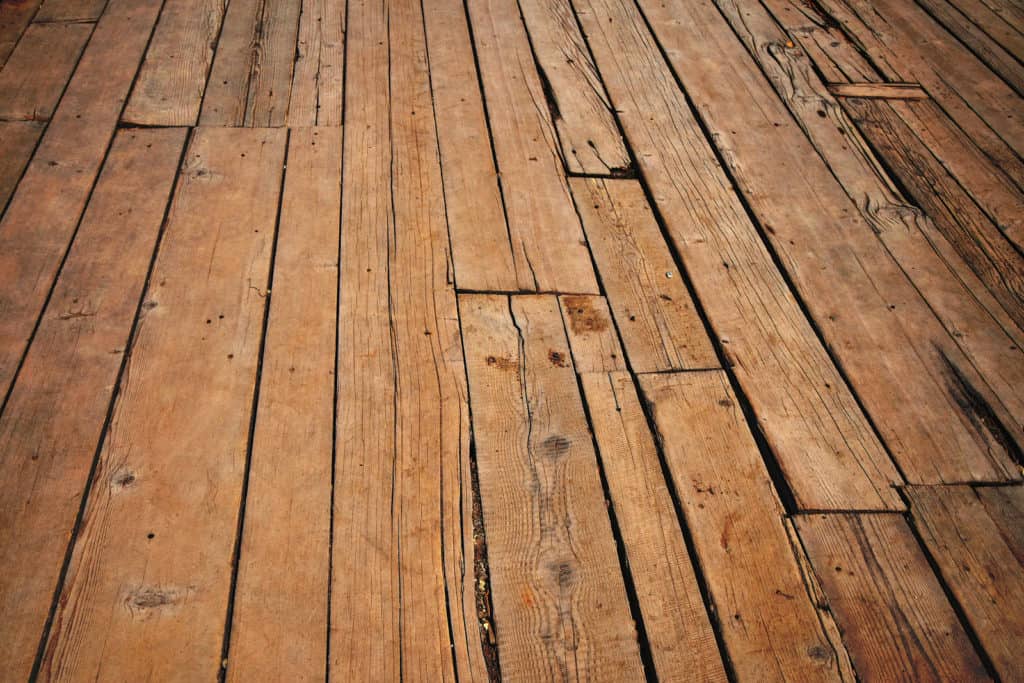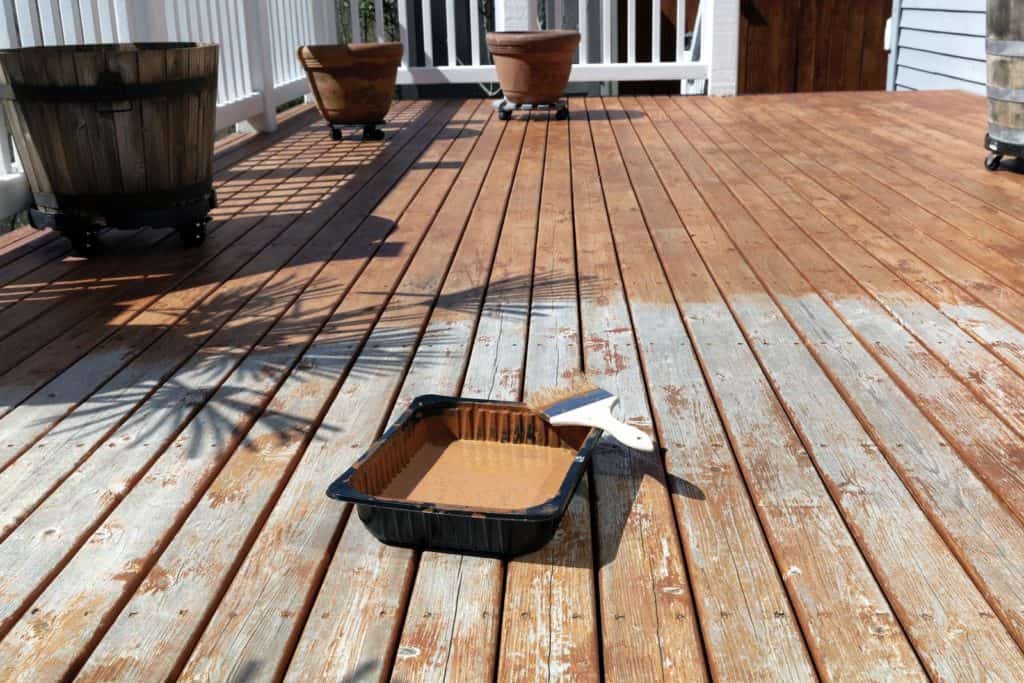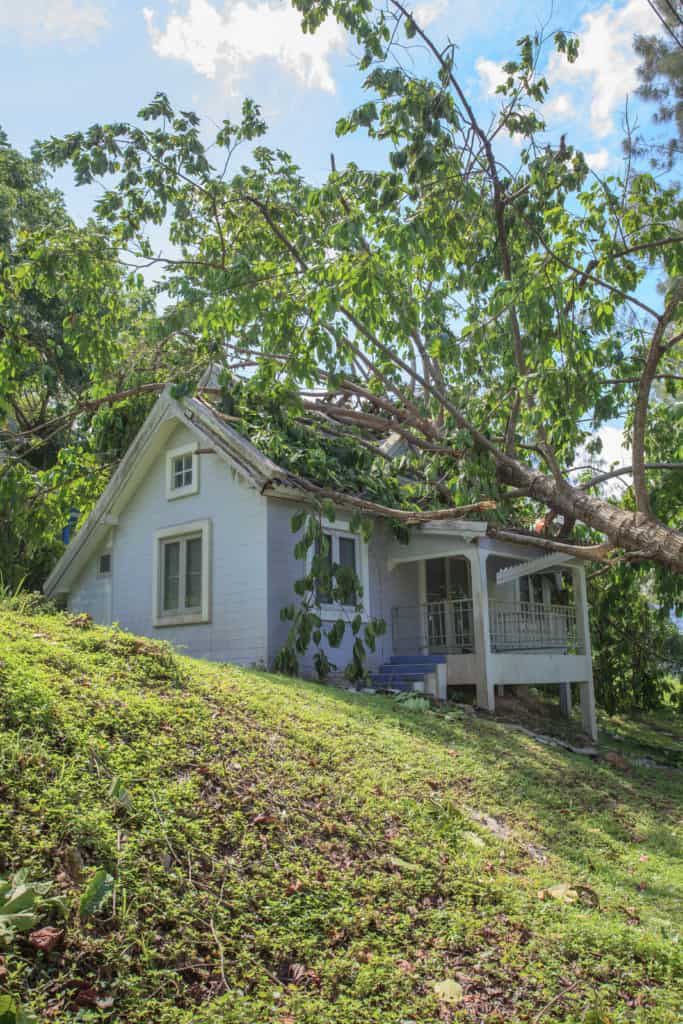Outdoor living space is a blessing and a curse. If you spend lots of time lounging on your deck or patio, you appreciate the “blessing” side. But if you have ever had to make deck repairs or re-stain your deck, you understand the curse as well.
The fact is, the need to make deck repairs is a common and recurring problem faced by homeowners. As you might expect, a wooden deck is much more susceptible to degradation and failure over time, versus composite decking. This article primarily focuses on problems related to wood decks, but composite decks also face some of the issues discussed below.
If you notice cracks or gaps or rotting, or other problems with your deck, don’t panic. There are ways to fix most of them without having to replace the entire structure.
Let’s take a look at the major types of deck damage and problems you may be facing and discuss the necessary deck repairs for each one.
Common Deck Problems
1. Cracked or Split Deck Boards

Weather is relentless, from rain and snow to temperature variations, scorching sun and more. These all combine to attack the wood on your deck. Over time, with years of exposure to the elements, the boards can begin to crack or split, making the deck a safety hazard. Even if there’s not a threat to your deck’s structural integrity, there may still be a threat to bare feet as you walk around on your deck.
Replacing the defective boards is a common fix for this problem, and is typically quick and won’t cost anything close to completely replacing an entire deck.
Keeping your deck protected with stain and sealants can help prevent cracking, splitting and rot.
2. Warped Deck Boards
Another issue with deck boards is warping. Warping is the result of moisture. When a portion of the board dries at a faster rate than another portion, warping will occur. It may be possible to correct these warped boards without the need to replace them, but replacement may be the best option if the boards are warped too much.
3. Loose Nails, Screws and Bolts
Deck boards, posts, supports, rails and other parts are connected using various nails, screws and bolts. When these fail, decks can lose structural integrity.
Of the three types of hardware, nails are most likely to fail. Constant exposure to rain makes it common for nails to rust and for nail heads to break off the nails. When the heads come off, you’ll end up with loose boards and other parts.
Screwing down deck boards and other parts of a deck is ideal, although building codes may require nails for certain parts of a job.
Bolts are used for load-bearing structural connections. Decks that are built incorrectly may lack bolts, and should be added as soon as possible to avoid structural damage, deck collapses and serious injury.
If you are experiencing loose parts on your deck, get your deck checked out by a professional as soon as possible to avoid injury.
4. Rotten Deck Posts and Boards
Wood rot results from wood that is above a certain moisture threshold. This moisture allows a fungus to grow and eventually destroy the wood.
Wood decks need protection from moisture. Regular application of a stain and/or sealant helps to prevent moisture infiltration. When this protection fails after repeated exposure to the elements, moisture may begin to accumulate in the wood, thereby allowing fungus to form and wood rot to take place.
Moisture can also come from the ground. Deck posts that aren’t properly installed may be placed directly in the ground. When this happens, moisture can easily penetrate the wood and allow it to rot. Posts should be installed on concrete deck footings in most cases, to prevent this moisture problem.
If you find rotten wood on your deck, get it replaced before additional damage occurs due to collapse.
5. Discoloration and Fading

When decks are first installed, a protective stain, sealant or paint is normally applied after an initial period of drying. This protection can last two to three years, after which time the deck will need to be re-stained and/or sealed. This is normal, and necessary to maintain the “health” of your deck.
As the stain color fades, decks will often begin to look gray or discolored. Fortunately, this fading is easily remedied with a new application of stain.
Staining and sealing are fairly simple DIY projects, but a professional can take care of this for you as well.
Keeping your deck sealed against weather and sun is your best bet for extending the life of your deck. Deck stain is much cheaper than most deck repair projects.
6. Unstable Railings And Stairs
When you begin to detect wobbling or sponginess in your deck’s railings or stairs, it’s time to get serious about determining the cause and making repairs.
A number of forces may cause portions of your deck to wobble and move, from wood rot, to termite infestation and damage to rusted nails, screws and bolts, to incorrect construction and installation.
Determining the cause and the appropriate corrective measure is serious business and you’ll want to have a professional look at your deck. Not correcting this type of problem is risky, and could endanger anyone walking on your deck.
7. Pest Infestation and Damage
As mentioned above, termites may damage a deck, to the point of making it dangerous. Other pests that might affect a deck include carpenter bees, woodpeckers and other birds.
Correcting these infestations and resultant damage will vary based on how long it has been happening and the extent of the damage. Taking steps to prevent further damage may involve pest treatment from an appropriate pest control or other provider.
8. Footings Moving or Damaged
Footings are concrete pads that are installed under the deck. Most decks will have several footings, one for each post that supports the deck.
For each footing, a hole is dug and concrete is poured into the hole and allowed to cure. The depth of the hole will vary depending on local building codes and temperatures.
The frost line is the depth above which moisture in the soil may freeze. Soil above this line is subject to movement and heaving upward. If footers are not buried below this frost line, they can move up and down when freezing and warming occur, thus damaging a deck. When water freezes, it expands and tends to make the ground rise. Think about how ice floats. Frozen water below ground wants to behave similar to ice floating in a drink.
The depth of the frost line is much deeper in colder regions, and footers must be installed below this depth. If they are installed incorrectly, heaving can occur. Reinstalling footings at the proper depth will be necessary to stop this movement.
Deck posts should be placed on top of concrete footings, in most cases. These footings are usually very stable, but a number of factors can cause footings to move or deteriorate, making the deck post, and the entire deck, unstable.
Over time, under the stress of temperature variations, water infiltration and other causes, footings may crack and crumble. Replacing them with new footings that meet building codes and weather requirements will be necessary. Temporary bracing of a deck is normally required in such circumstances, until the existing posts can be put back on top of the new footings, and is probably a job best left to professional deck contractors.
9. Erosion Around Footings/Posts
Erosion doesn’t directly or immediately damage a deck. However, if left untreated, it can cause irreparable and possibly total damage to a deck. Decks depend on stable posts. When the soil around the footings that support those posts is disturbed due to drainage issues, that can lead to posts moving laterally, sinking or being knocked out of place and, ultimately, collapse of a deck.
Correcting erosion problems will likely require re-routing drain water coming from gutters and downspouts well away from the deck.
10. Sinking
A sinking deck may be the result of obvious, visible erosion around footings. It may also be the result of less obvious, invisible factors. If the ground below a deck was not compacted properly prior to construction, it can subside or sink. Correcting a sinking deck may require compaction of the soil and/or new footings, installed at a lower depth. Helical piers that reach down to a lower level where the soil is compacted might also be employed.
11. Sagging
If you have sagging areas on your deck, take steps immediately to get it checked out and corrected. Sagging is often an indication of footings, posts or joists that are compromised in some manner, meaning the structural integrity of the entire deck may be at risk.
Have a professional inspection of the entire deck to ascertain the cause, then take steps to mitigate the problem as soon as possible.
12. Mold, Algae

Mold is a fungus that can grow on decks when conditions are right. Mold spores can easily blow onto a deck, and when moisture and the right temperature and a food source are present, mold can begin to grow. It appears as a black or dark green film.
Algae is a green, sometimes slimy, film that can grow on a deck.
Both algae and mold are unsightly and can damage your wood deck. And algae can be dangerously slippery. Removing both is important for the look and longevity of your deck.
Removing mold and algae will likely require a chemical treatment. A power washer can actually make the problem worse by driving mold deeper into the wood where it can continue to grow. Chemically treating the problem is your best option. Applying a preventative deck treatment will keep mold or algae from returning once you have removed it.
13. Falling Limbs and Trees

Trees occasionally shed limbs as they age or die, or due to overloading by ice or snow, or by high winds. Larger limbs can sometimes inflict damage if they happen to fall on a deck. Sometimes an entire tree may come down and do major damage or even take out an entire deck. In either case, you may want to have a professional check the integrity of the structure to assure the deck is safe. Rails are easily damaged by limbs and may require replacement. Most important is the underlying support structure. Make sure joists and posts are in good condition.
Conclusion
A well-built deck can easily last twenty to thirty years or more. By regularly applying sealants to the deck surface, you can extend the life by many more years. Deck repairs won’t be nearly as frequent if you can do a bit of deck sealing every couple of years.
At least once per year, carefully examine your deck for water damage, wood rot, splintered wood, broken boards, loose and wobbly boards and stairs, and any other signs of problems directly on the deck itself. Also, verify the integrity of the footings, making sure they are intact and stable.
If your carpentry skills are good, you may want to take on minor deck repairs yourself. However, major deck restoration or deck replacement is usually best left to a reputable deck contractor who will follow all building codes and local permitting requirements. There are numerous safety issues, both during construction and afterward, when a deck is being used. Make sure construction is done correctly.
If you are located in Metro Atlanta, Halcyon Remodeling is ready to help you with your deck repair needs. We can assess the problems with your deck and recommend deck repairs, or help you replace your deck if necessary. If you want to add a new deck to your home, we’d love to help you with that also.
Contact us now to discuss your deck repair or deck installation needs.
